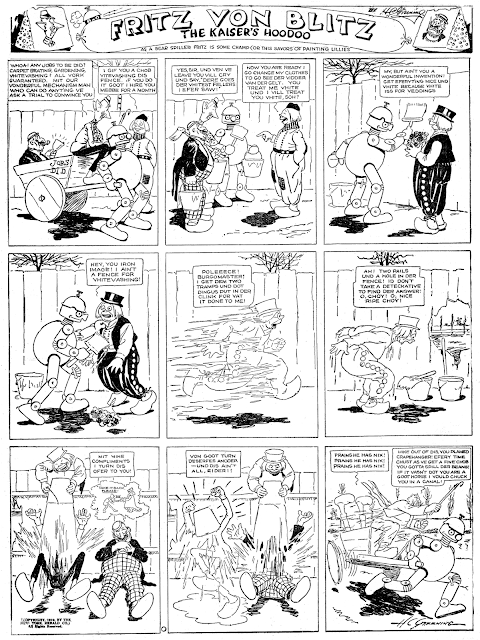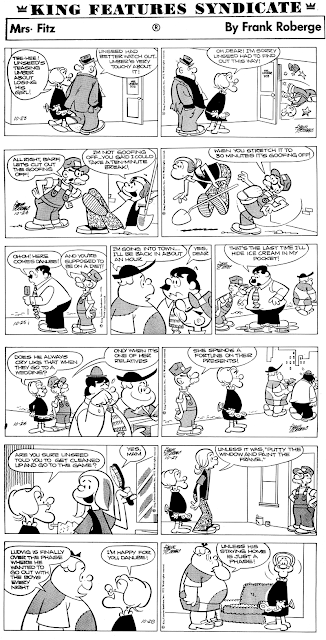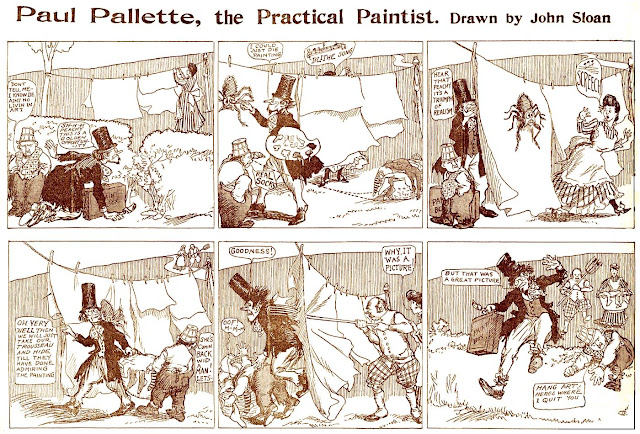Saturday, April 01, 2023
Herriman Saturday: May 22 1910
May 22 1910 -- Apparently the latest men's clothing fashions coming out of London are showing a new interest in colour. Herriman has his inch, so he takes a mile for this cartoon.
Labels: Herriman's LA Examiner Cartoons
Friday, March 31, 2023
Obscurity of the Day Revisited: Fritz Von Blitz, the Kaiser's Hoodoo
Ha ha, der choke ist on me! Dis obscurisch was covered vay back in 2006, when dis blog vas onny der kinder. Cole Johnson dat dodgast scannering damon sent more of der fotos, unt fool dat I am, I fix 'em up fer dot blog. Brains I has nix!
*ahem*
So what can we learn from these samples that we didn't before? Well, you can certainly use them to polish your Pidgin German. Beyond that, the bottom sample is interesting because it came long enough after the end of the war that Greening was trying to rejigger the plot for post-war use. So he just has Fritzi (he's the robot) and his masters running around the countryside looking for odd jobs. Not quite the impact of the really over-the-top wartime strips, so you can see why the series ended.
I hesitate to bring it up, because I'm not sure, and I don't know if it has any deep abiding meaning anyway, but isn't the fellow in the top strip who is trying to sell gunpowder supposed to be a caricatured Jew? You don't see much of that in U.S. newspaper strips (other than Abie the Agent) even in those openly racist days, so it kind of pops out at me. Why did Greening choose that character? As far as I know, German anti-Semitism wasn't really much of an issue in World War I, was it? Is Greening just an anti-Semite looking for an excuse to portray the stereotypical money-grubbing Jew?
Labels: Obscurities
If the figue above is supposed to be a Jewish cariciture, it's an unusual one. the palms-up shrug and that in excitement he says "ooi" might indicate it, but I really don't think it is.
The Jew stereotype is usually drest in black,with the tight crown derby. A Jew would certainly would not have a small, upturned nose, and the frayed, overgrown moustache and beard. Those and the "stink" lines eminating from him are indicative of what Greening and most cartoonists would use for an anarchist. That's probably why he would be dealing in explosive or gunpowder by the barrel.
The third strip above is from early 1919. The Kaiser and Crown Prince have been deposed days before the war ended back in November 1918, and they high-tailed it to the safe haven of Doorn, Holland. Apparently the Herald, or Greening, wanted to keep the psycho robot gags going, and hatin' on Wilhelm too. But the terrible two, shorn of power and a war background, are reduced to standard streetcorner/barnyard comic strip pranks, now with wooden shoes. It's suprising it lasted that long. Think it might be the last WWI themed strip?
I think your initial hunch is the right one. While Hershfield in Abie the Agent, that featured a Jewish protagonist, deliberately avoided the stereotypical markers used to denote Jews, the character, here, in addition to the salesman's bag, while he doesn’t have a hook nose (too derogatory by this time), clearly demonstrates the other markers used to identify Jews: splayed feet and upright hands signifying wild gesticulation. These markers were commonly used in Puck and Judge cartoons in the late 1800s and early 1900s to signify Jews.
Wednesday, March 29, 2023
Firsts and Lasts: Mrs. Fitz's Flats is Condemned
Above is the final week of Mrs. Fitz's Flats, a strip that never really made a great impact on comics pages, but nevertheless ran for fifteen years, not a run to be sneezed at (gesundheit).
To look at the strip, you'd be forgiven if you assumed it was by Mort Walker. And you'd be partly right. Frank Roberge, the superintendent of Mrs. Fitz's Flats, was an assistant to Walker in the 1950s. Walker came up with the idea of an apartment building full of weirdos, presided over by a widow lady landlord. He got approval from King Features to run with the concept and he handed the reins over to Roberge, already well-proven to be able to draw in the Walker style. The daily-only strip debuted on January 7 1957. It was long assumed that the Walker shop wrote the strip from beginning to end, but Mort Walker says that he handed off the writing to Roberge after a relatively short time*.
The strip was attractive and the gags, spread out among a host of regulars, were strong enough if a little staid. So why didn't the strip catch on? Author Maurice Horn believes it is because the cast was too big and readers never felt intimate with the characters, while King Features archivist Mark Johnson feels that the setting, which is almost boarding house-like, was too old fashioned. I think they're both right.
Roberge tried to revive the strip by having Mrs. Fitz marry the superintendant and move to a retirement community in Florida. After a few years of that with no better subscription numbers, back went Mrs. Fitz to the apartment building. Near the end of the strip's life, Roberge even modified his art style to try to differentiate it from the other omnipresent Walker strips. That didn't help either, and the strip came to an abrupt end on October 28 1972. As you can see above, the final week offers no hint that the strip was ending.
According to Mark Johnson, this is because Roberge died unexpectedly while golfing, and so the strip was cancelled after his last submission was run. However, Lambiek Comiclopedia disagrees with that, saying that Roberge died in 1976. As Wimpy would say, "let's you and him fight."
Thanks to Mark Johnson, who supplied the syndicate proof shown above.
* Source: "Mort Walker: Conversations".
Labels: Firsts and Lasts
Johnn Sajem told me similar with "The Evermores". According to him, Walker came up with the idea (called "The History of Mr. and Mrs."), and with the initial 24-strip submission, Walker wrote half while Sajem wrote the rest. After King accepted the strip, Sajem did both writing and drawing for the rest of the run. Presumably, though, King marketed the strip with Walker's name to get the initial list of papers.
Thanks for the link to my old blog, I worked hard on it. My mea culpa for the wrong date of Robergé's death is, well, information supplied by those that actually knew and worked with him. Can't trust nobody no more.
This indicates that The strip was cancelled because it was simply not paying off.
One might think, at first look, that it would be a well-thought out idea; a cast of disparate characters that would all have their own little worlds to interact with. It worked in radio shows, Fred Allen did well with it; it can work in comic strips, look at Mort's own "Boner's Ark". But maybe Mrs. Fitz just seemed somewhat artificial, pre-packaged, generic sitcom stuff using rather timeworn archtypical characters from old books, movies and vaudeville. The gags weren't bad, but the setting and inhabitants were not interesting. No fan base appeared. There's no comic books or licencing, for instance.
There's only so many desperate sea-changes a series will take before you have to conclude that it's ebbing client list was an irreversible slide.
Re:EOCostello's obit saying the strip was still being syndicated in 1976
Is it safe to assume that King was syndicating the strip in reprints at that point, or could it actually have been new material? Or was the obit writer totally out in left field?
--Allan
Monday, March 27, 2023
Obscurity of the Day: Paul Palette, The Practical Paintist
A special treat of an obscurity today as we shine the spotlight on the only newspaper comic strip series penned by the great pioneering Ashcan School painter, John Sloan.
Sloan worked at the Philadelphia Press in the 1890s to 1910s because the income from his serious art was practically nonexistent at the time. His most remembered work there were his puzzle cartoons, a long-running weekly feature in which a set of illustrations could be reinterpreted to fit some specified category. For instance, if Sloan showed a bridge onto an island, and the category was US States, the illustration would represent Rhode (road) Island. (In actuality, the puzzles were generally quite tough to solve, unlike my elementary example).
Though Sloan produced all sorts of work for the Press, and he had an excellent sense of humour, for some reason he very rarely contributed to their homegrown Sunday comics section. He did some occasional one-shots, and just this one series, Paul Pallette the Practical Paintist (which eventually had its spelling error corrected to Palette).
For fans of Sloan, who know that he could see the humour in the art world and his own aspirations, a comic strip about a goofy artist seems like a natural outlet. Unfortunately, Paul Pallette is little more than a copy of Billy the Boy Artist except with an adult protagonist. Pallette is a champion for realism in art, and every time he fools someone into mistaking a painting for reality he is utterly delighted with his triumph even as he endures the negative consequences.
Since Billy the Boy Artist was rarely seen outside of Boston, Sloan could easily get away with his copycat strip with few readers the wiser, but it's still too bad he didn't take the opportunity to produce something more original. In any case, the strip did not last long. It debuted on October 22 1905 and last appeared January 7 1906. The above two samples, courtesy of Cole Johnson, are the first two of the series.
An interesting footnote to this series concerns Sloan's signature. Rather than sign with his name, Sloan playfully signed this strip with a dollar sign (seen above), the name 'Ivan Lanso', or a drawing of a snail, which is a playful self-reference to his near-legendary slowness in producing art.
Labels: Obscurities
Sloan was part of the group of rebelous impressionist artists known as "The Eight", who came along in the 1900s, notably a famous show at the MacBeth Gallery in 1908, where he and other untraditional painters were given their moniker.
Saying something about modern art, I guess, several of the daubers dabbled in comics, they were:
Arthur B. Davies
William Glackens
Robert Henri
Ernest Lawson
George B. Luks
Maurice Pendergast
Everett Shinn
John Sloan
Sunday, March 26, 2023
Wish You Were Here, from B. Cory Kilvert
This scarce card required some research. It gives every indication of being a newspaper giveaway, and originally coming on a sheet like the Hearst cards, where recipients have to cut out the individual cards. Poking around the interwebs I've managed to find a few other cards of the same design, where you can read the text at the bottom which has flaked off of my card. It says "Copyright 1904 by Associated Sunday Magazines, Inc."
This company came into being at the end of 1903, and supplied magazine sections to subscribing newspapers in the same way as McClure and others supplied boilerplate comics sections. Evidently in 1904 they decided to sweeten the pot with a postcard giveaway in those magazine sections. They even went to the trouble of customizing the postcards with the names of the subscribing papers.
Other cards of this design cite various other newspapers, the Boston Post being one of the more common. This particular example of mine comes from the Washington Star, which had the egotism to call themselves simply "The Sunday Star", without bothering to cite their city.
Oddly enough, though the Star is digitized on newspapers.com, I can find not one word in their 1904 papers that mentions this postcard giveaway. That's oddly reminiscent of the Hearst cards, which seem to have been given little if any marketing boost in their papers.
Although these cards fail to credit an artist for the cartoons, this card (and probably all of them) uses an image created by B. Cory Kilvert, as proven when I stumbled upon an alternate version of the same cartoon in which the signature wasn't cut off. It offers a somewhat ghoulish gag, wherein a naturally fidgety kid is subjected to a prolonged period of sitting perfectly still so that a photographer can get his picture. The "death chair" was another term for the electric chair used for executions.
I'm no authority on photography history, but my impression is that the era of long slow exposures was well over by 1904. Am I wrong?
Labels: Wish You Were Here
The wet plate required the subject to stay still for about ten seconds. The idea of the old brace to hold one's head still is a holdover from much earlier days, say, the Deguerretype era in the mid 19th century, when one had to hold still for a full minute or two.









